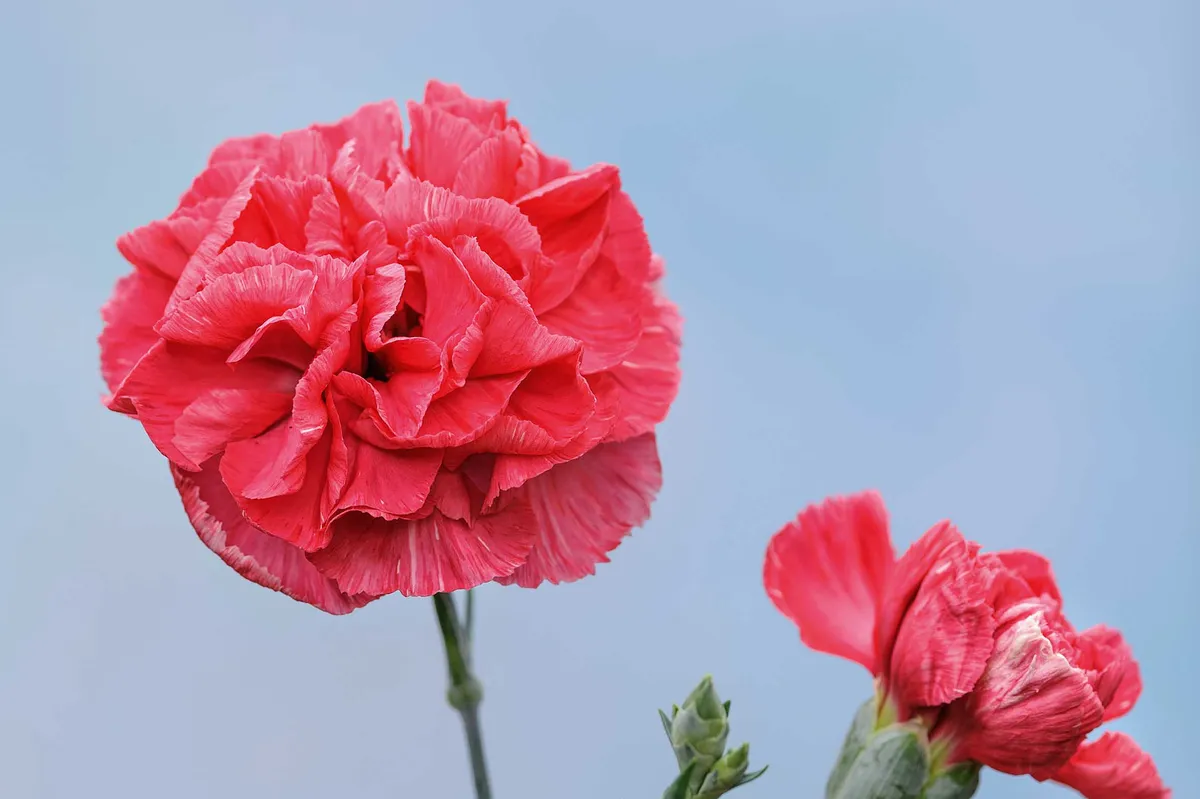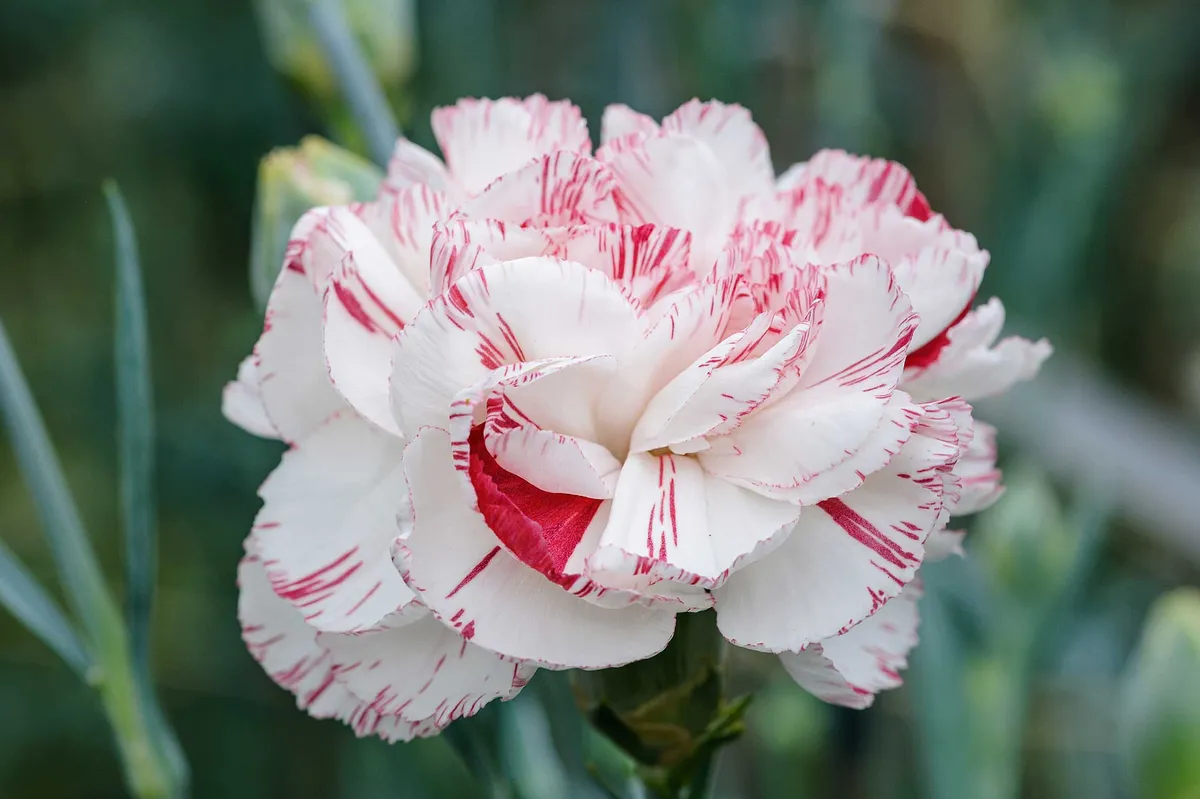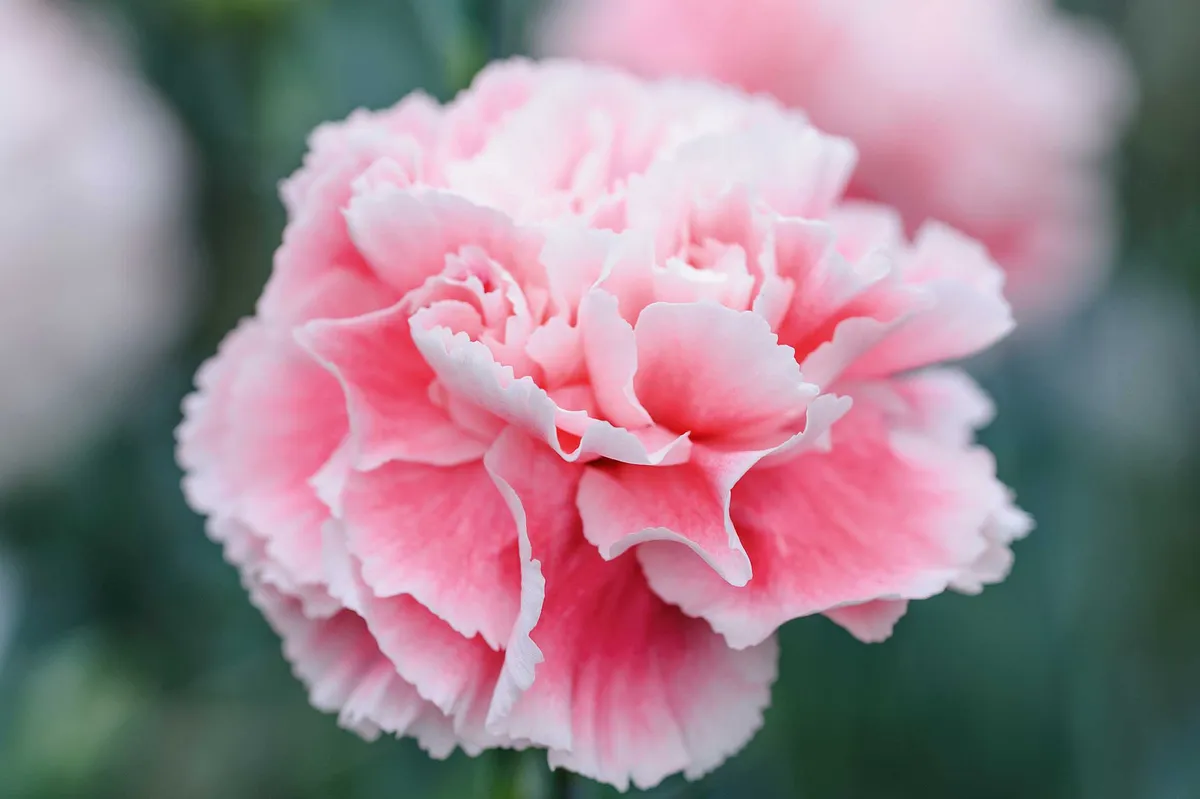The genus Dianthus belongs to the family Caryophyllaceae, which comprises 80 genera and 3,000 species. Dianthus caryophyllus, the original carnation, is endemic to southern Europe and was introduced into England about the time of the Norman Conquest.
The group of Dianthus known as perpetual flowering carnations are a result of crosses between Dianthus caryophyllus and Dianthus chinensis and originated in France at the turn of the 19th century. They have a branching habit and produce a flower at the end of each branch and, as their name suggests, bloom throughout the year.
The history of perpetual carnations
In the early 20th century carnation production was centred in the USA, and one of the most popular series of all time, the Sim series, was developed by Massachusetts breeder William Sim, a Scottish immigrant. In the UK, the nurseries of Engelmann and Allwoods soon started growing them and bred new cultivars. By the 1930s they had become the dominant glasshouse carnation, superseding the popular Malmaison carnations. These more fragrant carnations originated in France in the mid-19th century and became fashionable in the UK in the Edwardian era when they were grown in the glasshouses of many aristocrats. Offering large blooms with split calyces and a distinctive aroma of cloves, they flower only once in the summer for a short period.

Perpetual carnations in the UK
Jim Marshall, a former garden adviser to the National Trust, holds National Collections of both Malmaison and perpetual flowering carnations in his garden in Suffolk. Jim’s association with carnations is a long one. His grandfather, a keen amateur gardener, grew border carnations in his Edinburgh garden, and one of Jim’s first jobs in horticulture was for a commercial nursery that grew many of the Sims varieties, but his own collection of the perpetual types is relatively new and one he acquired almost by chance. Jim's collection includes 17 cultivars bred and registered in the UK before 1970. Today he is on a one-man mission to bring these beautiful flowers back into fashion, regularly showing both his carnation collections, and propagating plants for sale.
How to grow perpetual carnations
- Small-scale propagation is normally by stem cuttings taken from non-flowering ‘mother plants’ between February and October.
- Take cuttings in March, starting them off in a propagator with a bottom heat of 15°C and some mist. Once they’re rooted, normally after two to three weeks, pot them on into a mixture of peat-free compost with added perlite and controlled-release fertiliser.
- Jim uses one-litre pots and stops the plants – meaning he takes out the central shoot – allowing approximately four shoots to run up. These are kept in a cold frame until the summer and when ready Jim pots on plants for either flowering or propagation.
- Overfeeding at an early stage can inhibit flowering, but generally cultivation is relatively simple.
- Plants require protection from the wet both during the winter and while flowering. As they grow up to 1.8m tall, they will need some form of support. The traditional method is a central bamboo stick pushed into the pot, attached to which are hoops.
- As the stems elongate, they grow through the hoops, not only stopping the stems from snapping but also helping to keep them straight.
- The best blooms are obtained by ‘disbudding’ – only allowing the crown bud to flower. Timing is critical: too early and damage to the stem can be caused; too late and energy is wasted. When it comes to picking, Jim advises to come down seven buds to cut, and the shoots below will flower again in around four months. Jim keeps his plants for only one year, but they can be kept for longer.
When to plant perpetual flowering carnations
From early April give a weak feed (high in potash) every three weeks, then when buds start appearing give them a stronger feed every two weeks as the shoots run up to bloom.
The best perpetual carnation varieties for your garden
Dianthus 'Storm'

Beautifully coloured, like light sealed under a thunderous summer sky. Perfect as a specimen plant or grown en masse as a wash for the brighter carnations to play against. Little scent. 1.1m.
Dianthus 'Velvet Pelargonium'

Raised by Allwoods nursery, this carnation with sumptuous maroon flowers shaded with purple has a heavy clove scent that fills the air. Blooms over a long period and lasts several weeks in a vase. 1.25m.
Dianthus 'Royal Salmon'

An early cultivar raised by Allwoods nursery pre-1936 and given an RHS Award of Merit in 1946. Its dark salmon-coloured flowers fall between orange and pink depending on what you partner it with. 1.4m.
Dianthus 'Duchess of Roxburghe'

Beautiful flowers typical of the button-hole carnation in the palest pink. Slightly curled, glaucous leaves add to its beauty as does its heavy perfumed scent. If you grow only one, this should be it. 1.4m.
Dianthus 'Helena Allwood'

A reliable, fully double carnation with clean, white ground, striped a deep scarlet. One of the later carnations raised by Allwoods, it was given an RHS Award of Merit in 1952. Good scent. 1.25m.
Dianthus 'Fragrant Ann'

A creamy-white carnation that more than lives up to its name, with a spicy, clove-like fragrance. Raised by an amateur gardener in Derby in 1953, it was awarded an RHS First Class Certificate in 1980. 1.4m.
Dianthus 'Shot Silk'

Good-sized, fringed flowers with a chestnut ground, flaked, red-scarlet stripes and a good clove scent. One of Allwoods’ earliest greenhouse carnations, it was given an RHS Award of Merit in 1925. 1.25m
Dianthus 'Doris Allwood'

Raised by Allwoods and named for Montague Allwood’s wife Doris. Registered pre-1930, it was given an RHS Award of Merit in 1936. Beautifully coloured pink and blue grey and highly scented. 1.4m.
Dianthus 'Purple Frosted'

A cultivar raised in the USA by WD Holley of Colorado State University. Light-purple ground that is edged white. Stiffer in the stem than some, but still requires staking. Only lightly scented. 1.25m.
Dianthus 'Royal Crimson'

Raised in 1944 by Allwoods, the nursery responsible for many introductions, particularly the Allwoodii Group of pinks. It has a deep crimson colour with a good scent. 1.4m
Dianthus 'Northland'

A white carnation with a good scent. Introduced in the USA in 1939 by prolific breeder William Sim, who introduced the very popular range of Sim Carnations in the 1950s. 1.4m
Dianthus 'Monty's Pink'

Raised by Allwoods, and named for Montague Allwood, the eldest of the three brothers who started the company in 1910. Those named for the other two, George and Edward, are thought to be lost. 1.25m.
Dianthus 'Old Rose Pelargonium'

One of Jim’s favourites, raised by Allwoods nursery in 1950. Flowers are a wonderful old rose colour with nut-brown undertones. Works well in a vase with lighter toned carnations. Good scent. 1.25m.
Dianthus 'Marchioness of Headfort'

Lightly scented flowers in salmon with white edges. Raised by JA Boyle, head gardener of Headfort House in County Meath, Ireland, and named for Rose Boote, the 4th Marchioness. 1.1m.
Dianthus 'Earl Kelso'

Registered by Jim Marshall in 2012, this sport of D. ‘Duke of Norfolk’, has fully double, creamy-white flowers that are wide and shallowly toothed at the edges. A newer introduction that is well worth growing. 1.25m.
Where to buy perpetual flowering carnations
Allwoods, London Road, Hassocks,
West Sussex BN6 9NA.
Tel 01273 844229, allwoods.net